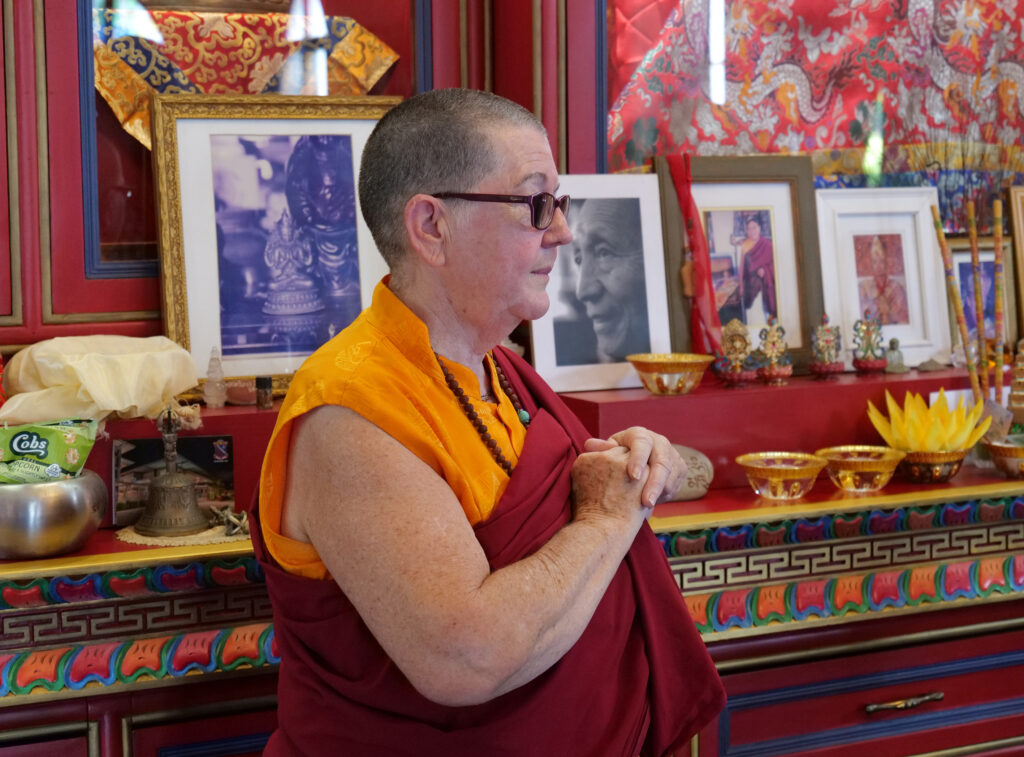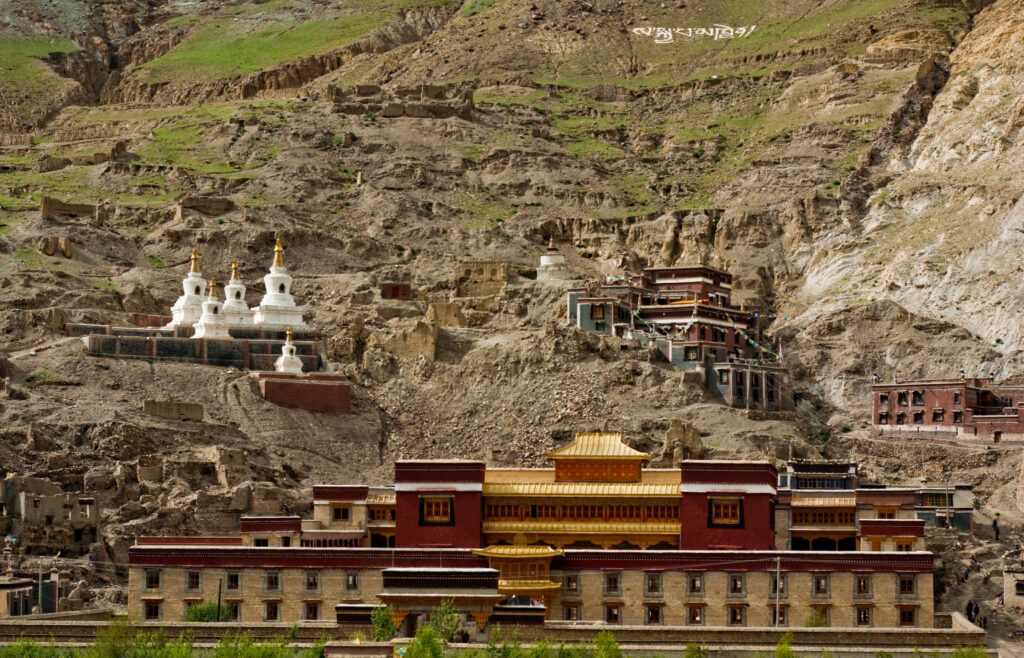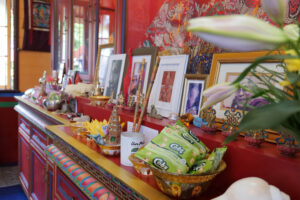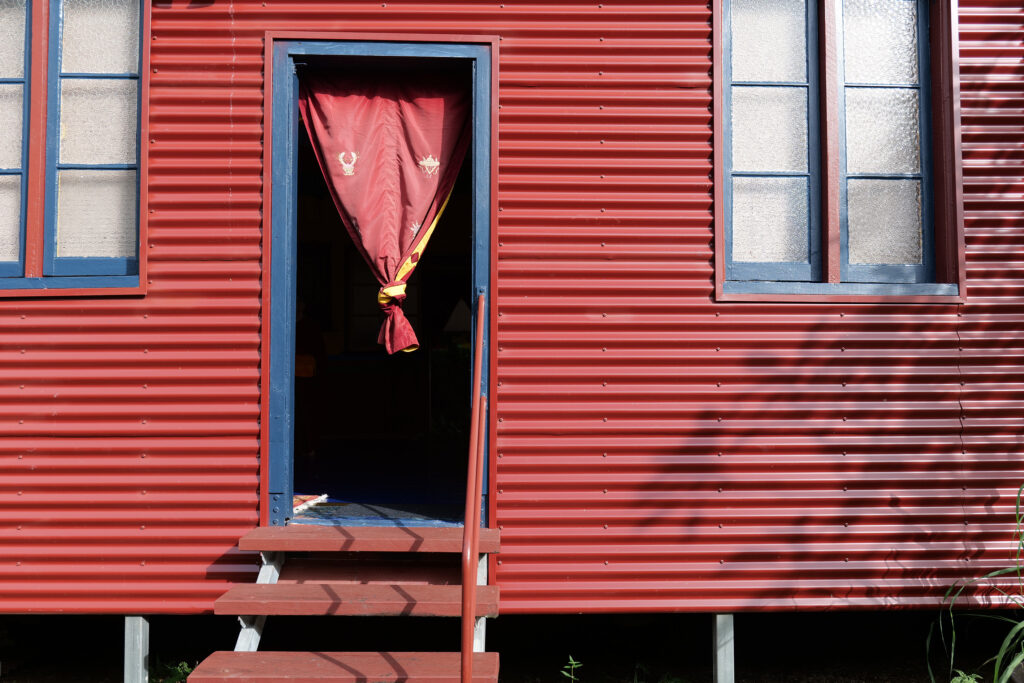Venerable Rinchen
A Buddhist initiated into a Sakya lineage in the Tibetan tradition, Venerable Rinchen established the Khacho Yulo Ling Buddhist Centre in Cairns. The centre has become a hub for community groups interested in spiritual well-being. Ven. Rinchen has also long been involved in palliative care in the wider Cairns region.
By Adam Bowles
This is a 5 minute read and a 30 minute video, published June 2024.
On a Cairns street west of the city’s bustling tourist centre is a modest building painted deep maroon with Tibetan prayer flags stretched across its tree-lined front fence. The building, a former Assemblies of God church, is home to a gompa, the Khacho Yulo Ling Buddhist Centre. Inside, wearing robes of a similar hue to the building, will be Venerable Rinchen, the Centre’s resident nun.
Venerable Rinchen has been initiated into a Sakya lineage in the Tibetan Buddhist tradition and fully ordained as a Bhikshuni in the Vietnamese Buddhist tradition. The Sakya (or Sa skya) lineage is one of four associated with what is popularly called ‘Tibetan Buddhism’. The Sakya school takes its name (which means ‘grey earth’) from the colour of the landscape in southern Tibet — today, part of the Tibetan Autonomous Region in China — where the famed Sa Skya monastery, the school’s first, was built in 1073.
Venerable Rinchen describes her discovery of Buddhism led to an immense personal transformation, pushing her to develop and exercise compassion — a key Buddhist ethical idea — in order to relieve what is referred to as duhkha (usually rendered into English as ‘suffering’) in herself and others. Since moving to Cairns, she has worked extensively in palliative care in the wider Cairns region, assisting the dying and their families in the last period of their lives.
Venerable Rinchen does not engage in such practice as part of her religious vocation as a Buddhist nun; ministering to anyone, her personal religious convictions in this context remain her own. Even so, her experiences as a Buddhist have afforded her particular skills and insights for the sharing and talking through of what are often very difficult periods in people’s lives.
Oral history interview: Venerable Rinchen
Spiritual guides and the Tibetan Buddhist tradition
Venerable Rinchen identifies as her most important spiritual guides two especially significant leaders of the Sakya tradition. Both have visited Cairns: His Holiness Kyabgon Gongma Trichen Rinpoche and His Eminence Chogye Trichen Rinpoche, Ngawang Khyenrab Thupten Lekshe Gyatso. Chogye Trichen, who passed away in 2007 in Kathmandu, was regarded as a great tantric practitioner and monastic, counting among his disciples the current Dalai Lama. The Centre received its name from Chogye Trichen after he conducted a divination ritual during one of his visits to Cairns. Kyabgon Gongma Trichen was the 41st Sakya Trizin, the hereditary throne-holder of the Sakya lineage, a position he held for over fifty years until he passed it to his eldest son in 2017.
Both Kyabgon Gongma Trichen and Chogye Trichen were born in Tibet. They departed, as did many other Tibetans, after the suppression by the Chinese People’s Liberation Army of the Tibetan uprising in 1959, which was a response to growing dissatisfaction with the political control asserted by the People’s Republic of China since 1951 and perceptions of threats to the Dalai Lama (van Schaik, 2011: 224–37). For Tibetans, this period was one of enormous social, political, and cultural disruption and consequence.
Political and religious leaders — such as the Dalai Lama, Kyabgon Gongma Trichen, and Chogye Trichen — escaped to Nepal and north India, organising settlements in exile and, frequently, religious sites. Kyabgon Gongma Trichen established a new centre for the Sakya school in Rajpur in the Indian state now known as Uttarakhand. Chogye Trichen ministered at Sakya monasteries in Mustang, Nepal, eventually establishing a Sakya retreat centre there, and established a monastery at Lumbini, the Buddha’s birthplace, also in Nepal (Jackson, 2020: vol.1, 132–54; Gardner, n.d.), both of which Venerable Rinchen has visited.
The movement of Tibetans as refugees into India, Nepal, and further afield, ultimately led to the promulgation of Tibetan Buddhist traditions in new contexts. Tourists would encounter them on their travels to the sub-continent; similarly, Tibetans travelled to North America, Europe, and Australasia, frequently as émigrés and refugees, but in the case of religious leaders more typically by invitation for speaking tours. Tibetan Buddhism, a numerically small tradition in the wider global Buddhist ecumene, began to attract increasing numbers of followers from non-Tibetan contexts.
A form of Mahayana Buddhism, Tibetan Buddhism can be distinguished from other types of Mahayana due to its focus on texts (frequently called ‘tantras’) that articulate ritual practices often subject to esoteric transmission, such as initiation, mantra practice, and visualisation. Sometimes this type of Buddhism is associated with the terms Vajrayana (the ‘thunderbolt/diamond vehicle’), wherein the term vajra (‘thunderbolt’ or ‘diamond’) is both symbolic and the name of a ritual implement used in liturgy, and Mantrayana (the ‘Mantra vehicle’), which is indicative of the central role in it of mantra recitation. Despite it commonly being referred to as ‘Tibetan’, this type of Buddhism is also characteristic of Bhutan, Mongolia, parts of Nepal, and parts of North India, and historically elsewhere in the wider Buddhist influenced world, including areas identified today with Theravada. Tantric Buddhism — and Tantra more broadly — in the northern Indian sub-continent in the sixth and seventh centuries, and was then transmitted to Tibet from the seventh to twelfth centuries.
The Khacho Yulo Ling Buddhist Centre, a peculiarly Far North Queensland expression of Tibetan Buddhism, is a testament to Venerable Rinchen’s determination, resilience, and capacity to embrace change, in her own life and for others’. A thriving community hub welcoming people of varied backgrounds and interests, the center has become a focal point for the well-being of the people of Cairns, and an important gathering place for Cairns’ Buddhists.
References and further reading
Gardner, Alexander. n.d. ‘The Eighteenth Chogye Trichen, Tubten Lekshe Gyatso.’ Treasury of Lives. Accessed November 28, 2023, http://treasuryoflives.org/biographies/view/Eighteenth-Chogye-Trichen-Tubten-Lekshe-Gyatso/12479.
Jackson, David P. 2020. Lama of Lamas: The Life of the Vajra-Master Chogye Trichen Rinpoche. 2 vols. Kathmandu: Vajra Books.
Kapstein, Matthew T. 2013. Tibetan Buddhism: A Very Short Introduction. Oxford: Oxford University Press.
van Schaik, Sam. 2011. Tibet: A History. New Haven: Yale University Press.
Related articles





